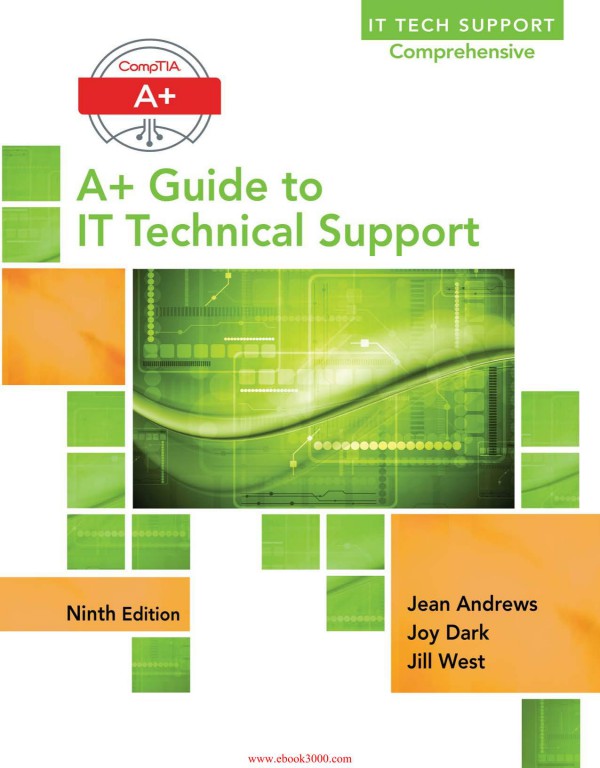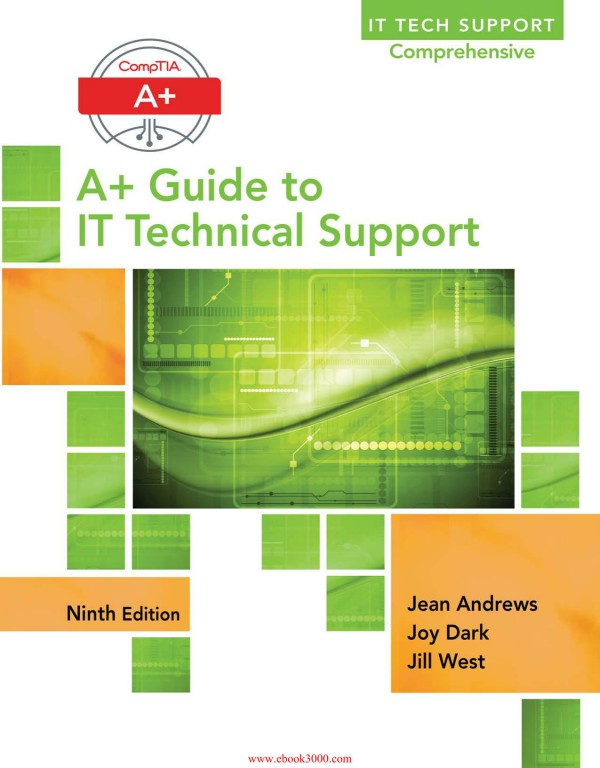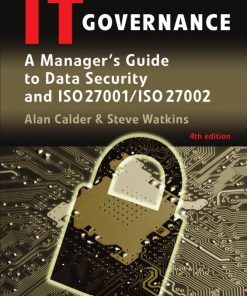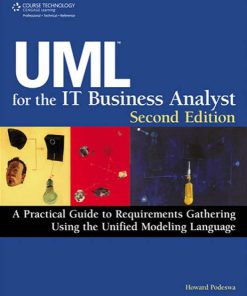A Guide to IT Technical Support 9th Edition by Jean Andrews ISBN 1305266439 9781305266438
$50.00 Original price was: $50.00.$25.00Current price is: $25.00.
Authors:Jean Andrews , Series:IT & Computer [311] , Tags:Computers; Hardware; Personal Computers; General; www.ebook3000.com , Author sort:Andrews, Jean , Ids:Google; 9781337345842 , Languages:Languages:eng , Published:Published:Jan 2016 , Publisher:Cengage Learning , Comments:Comments:This step-by-step, highly visual text provides a comprehensive introduction to managing and maintaining computer hardware and software. Written by best-selling author and educator Jean Andrews, A+ Guide to IT Technical Support, 9th Edition closely integrates the CompTIA+ Exam objectives to prepare you for the 220-901 and 220-902 certification exams. The new Ninth Edition also features extensive updates to reflect current technology, techniques, and industry standards in the dynamic, fast-paced field of PC repair and information technology. Each chapter covers both core concepts and advanced topics, organizing material to facilitate practical application and encourage you to learn by doing. The new edition features more coverage of updated hardware, security, virtualization, new coverage of cloud computing, Linux and Mac OS, and increased emphasis on mobile devices. Supported by a wide range of supplemental resources to enhance learning with Lab Manuals, CourseNotes online labs and the optional MindTap that includes online labs, certification test prep and interactive exercises and activities, this proven text offers students an ideal way to prepare for success as a professional IT support technician and administrator.Important Notice: Media content referenced within the product description or the product text may not be available in the ebook version.
A Guide to IT Technical Support 9th Edition by Jean Andrews – Ebook PDF Instant Download/Delivery. 1305266439, 9781305266438
Full download A Guide to IT Technical Support 9th Edition after payment

Product details:
ISBN 10: 1305266439
ISBN 13: 9781305266438
Author: Jean Andrews
This step-by-step, highly visual text provides a comprehensive introduction to managing and maintaining computer hardware and software. Written by best-selling author and educator Jean Andrews, A Guide to IT Technical Support, 9th Edition closely integrates the CompTIA Exam objectives to prepare you for the 220-901 and 220-902 certification exams. The new Ninth Edition also features extensive updates to reflect current technology, techniques, and industry standards in the dynamic, fast-paced field of PC repair and information technology. Each chapter covers both core concepts and advanced topics, organizing material to facilitate practical application and encourage you to learn by doing. The new edition features more coverage of updated hardware, security, virtualization, new coverage of cloud computing, Linux and Mac OS, and increased emphasis on mobile devices. Supported by a wide range of supplemental resources to enhance learning with Lab Manuals, CourseNotes online labs and the optional MindTap that includes online labs, certification test prep and interactive exercises and activities, this proven text offers students an ideal way to prepare for success as a professional IT support technician and administrator.
A Guide to IT Technical Support 9th Table of contents:
Chapter 1. First Look at Computer Parts and Tools
What’s Inside a Desktop Case
Form Factors Used by Desktop Cases, Power Supplies,and Motherboards
Drives, Their Cables, and Connectors
First Look at Laptop Components
Special Keys, Buttons, and Input Devices on a Laptop
ExpressCard Slots
Docking Stations
Laptop Internal Components
What’s Inside an All-in-One Computer
Maintaining Laptops and Mobile Devices
First Look at Mobile Device Hardware
Connection Types
Storage Devices
Mobile Device Accessories
Field-Replaceable Parts for Mobile Devices
Tools Used by a Computer Hardware Technician
Post Diagnostic Cards
Power Supply Tester
Multimeter
Loopback Plugs
Chapter Summary
Key Terms
Reviewing the Basics
Thinking Critically
Real Problems, Real Solutions
Chapter 2. Working Inside Desktop Computers and Laptops
How to Work Inside a Desktop Computer Case
Step 1: Plan and Organize Your Work
Step 2: Open the Computer Case and Examine the System
Step 3: Remove Expansion Cards
Step 4: Remove the Motherboard, Power Supply, and Drives
Steps to Put a Computer Back Together
Special Considerations When Supporting Laptops
Warranty Concerns
Service Manuals and Other Sources of Information
Diagnostic Tools Provided by Manufacturers
How to Work Inside a Laptop Computer
Chapter Summary
Key Terms
Reviewing the Basics
Thinking Critically
Real Problems, Real Solutions
Chapter 3. All About Motherboards
Motherboard Types and Features
Motherboard Form Factors
Processor Sockets
The Chipset
Buses and Expansion Slots
Onboard Ports and Connectors
Configuring a Motherboard
Using BIOS Setup to Configure a Motherboard
Using UEFI Setup to Configure a Motherboard
Maintaining a Motherboard
Updating Motherboard Drivers
Flashing BIOS
Flashing UEFI
Using Jumpers to Clear BIOS Settings
Replacing the CMOS Battery
Installing or Replacing a Motherboard
How to Select a Desktop Motherboard
How to Install or Replace a Motherboard
Replacing a Laptop System Board
Chapter Summary
Key Terms
Reviewing the Basics
Thinking Critically
Real Problems, Real Solutions
Chapter 4. Supporting Processors and Upgrading Memory
Types and Characteristics of Processors
How a Processor Works
Intel Processors
AMD Processors
Selecting and Installing a Processor
Select a Processor to Match System Needs
Install a Processor
Replacing the Processor in a Laptop
Memory Technologies
DIMM Technologies
How to Upgrade Memory
How Much Memory Do I Need and How Much Is Currently Installed?
How Many and What Kind of Memory Modules Are Currently Installed?
How Many and What Kind of Modules Can Fit on My Motherboard?
How Do I Select and Purchase the Right Memory Modules?
How Do I Install the New Modules?
How to Upgrade Memory on a Laptop
Chapter Summary
Key Terms
Reviewing the Basics
Thinking Critically
Real Problems, Real Solutions
Chapter 5. Supporting the Power System and Troubleshooting Computers
Cooling Methods and Devices
Processor Coolers, Fans, and Heat Sinks
Case Fans and Other Fans and Heat Sinks
Liquid Cooling Systems
Selecting a Power Supply
Types and Characteristics of Power Supplies
How to Calculate Wattage Capacity
How to Approach a Hardware Problem
Step 1: Interview the User
Step 2: Back up Data as Needed
Step 3: Examine the System and Establish a Theory
Steps 4, 5, and 6: Fix the Problem, Verify the Fix, and Document the Outcome
Special Concerns When Troubleshooting Mobile Device Hardware
Troubleshooting the Electrical System
Problems That Come and Go
Power Problems with the Motherboard
Problems with Overheating
Problems with Laptop Power Systems
Troubleshooting the Motherboard, Processor, and RAM
Troubleshooting Mobile Devices
Chapter Summary
Key Terms
Reviewing the Basics
Thinking Critically
Real Problems, Real Solutions
Chapter 6. Supporting Hard Drives and Other Storage Devices
Hard Drive Technologies and Interface Standards
Technologies Used Inside a Hard Drive
SATA Interface Standards Used by a Hard Drive
How to Select and Install Hard Drives
Selecting a Hard Drive
Steps to Install a SATA Drive
Installing a Drive in a Removable Bay
Installing a Small Drive in a Wide Bay
Installing a Hard Drive in a Laptop
Setting up Hardware RAID
External Enclosures
Identifying Tape Drives
Supporting Other Types of Storage Devices
File Systems Used by Storage Devices
Standards Used by Optical Drives and Discs
Installing an Optical Drive
Replacing an Optical Drive on a Laptop
Solid-State Storage
Troubleshooting Hard Drives
Slow Performance
Hard Drive Problems during the Boot
Chapter Summary
Key Terms
Reviewing the Basics
Thinking Critically
Real Problems, Real Solutions
Chapter 7. Survey of Windows Features and Support Tools
Windows Interfaces
Windows 8 Modern Interface
Windows 8 Desktop
Windows Tools for Users and Technicians
Windows 8 File Explorer and Windows 7 Windows Explorer
Control Panel
Folder Options
Power Options
System Window
System Information Window
Action Center
Windows Network Connections
Windows Workgroup and Homegroup
Windows Domain
Public and Private Networks
Make a Windows 8 Network Connection
Domain Setup
Windows User Accounts
Using a Microsoft Account with Windows 8
User Account Control Dialog Box
Chapter Summary
Key Terms
Reviewing the Basics
Thinking Critically
Real Problems, Real Solutions
Chapter 8. Installing Windows
How to Plan a Windows Installation
Choose the Edition, License, and Version of Windows
Verify Your System Qualifies for Windows
Installations with Special Considerations
Choose the Type of Installation: In-Place Upgrade, Clean Install, or Dual Boot
Understand the Choices You’ll Make during the Installation
Final Checklist before Beginning the Installation
Installing Windows 8.1 and Windows 7
Steps to Perform a Windows 8.1 In-Place Upgrade
Windows 8.1 Upgrade from Microsoft Website
Windows 7 in-Place Upgrade
Steps to Perform a Windows 8.1 Clean Install
Steps to Perform a Windows 7 Clean Install
Steps to Set up a Windows Multiboot
Using an Upgrade Product Key on a New Hard Drive
What to Do after a Windows Installation
Verify You Have Network Access
Activate Windows
Install Windows Updates and Service Packs
Install Hardware
Install Applications
Set up User Accounts and Transfer User Data
Turn Windows Features on or Off
Special Concerns When Working in a Large Enterprise
Deployment Strategies for Windows
Using the USMT Software
Chapter Summary
Key Terms
Reviewing the Basics
Thinking Critically
Real Problems, Real Solutions
Chapter 9. Supporting I/O Devices
Basic Principles for Supporting Devices
Ports and Wireless Connections Used by Peripheral Devices
Installing I/O Peripheral Devices
Mouse or Keyboard
Barcode Readers
Biometric Devices
Digital Cameras and Camcorders
Webcams
Graphics Tablets
Motion Controllers
MIDI Devices
Touch Screens
KVM Switches
Installing and Configuring Adapter Cards
Sound Cards and Onboard Sound
TV Tuner and Video Capture Cards
Replacing Expansion Cards in a Laptop
Supporting the Video Subsystem
Monitor Technologies and Features
Video Cards and Connectors
Changing Monitor Settings
Video Memory and Windows
Troubleshooting I/O Devices
NumLock Indicator Light
Device Manager
Troubleshooting Monitors and Video
Video System in a Laptop
Speakers in a Laptop
Chapter Summary.
Key Terms
Reviewing the Basics
Thinking Critically
Real Problems, Real Solutions
Chapter 10. Maintaining Windows
Schedule Preventive Maintenance
Verify Critical Windows Settings
Update Drivers and Firmware
Patch Management
Clean up the Hard Drive
Backup Procedures
Planning for Disaster Recovery
Back up User Data with Windows 8 File History
Back up Windows System Files
Windows 8 Custom Refresh Image
Managing Files, Folders, and Storage Devices
How Partitions and File Systems Work
Commands to Manage Files and Folders
Use Disk Management to Manage Hard Drives
Windows Storage Spaces
Chapter Summary
Key Terms
Reviewing the Basics
Thinking Critically
Real Problems, Real Solutions
Chapter 11. Optimizing Windows
Windows Utilities and Tools to Support the OS
What Are the Shell and the Kernel?
How Windows Manages Applications
Task Manager
Administrative Tools
System Configuration
Services Console
Computer Management
Microsoft Management Console (MMC)
Event Viewer
Print Management
Task Scheduler
Performance Monitor
Registry Editor
Display Settings and Graphics Software
Improving Windows Performance
Step 1: Perform Routine Maintenance
Step 2: Clean Windows Startup
Step 3: Check If the Hardware Can Support the OS
Step 4: Check for a History of Problems
Step 5: Consider Using ReadyBoost
Manually Removing Software
Step 1: First Try the Uninstall Routine
Step 2: Delete Program Files
Step 3: Delete Registry Entries
Step 4: Remove Program Shortcuts
Step 5: Remove Startup Processes
Chapter Summary
Key Terms
Reviewing the Basics
Thinking Critically
Real Problems, Real Solutions
Chapter 12. Supporting Customers and Troubleshooting Windows
What Customers Want: Beyond Technical Know-How
Becoming a Competent and Helpful Support Technician
Planning for Good Service
Strategies to Troubleshoot Any Computer Problem
Step 1: Interview the User and Back up Data
Step 2: Examine the System and Make Your Best Guess
Step 3: Test Your Theory
Step 4: Plan Your Solution and Then Fix the Problem
Step 5: Verify the Fix and Take Preventive Action
Step 6: Document What Happened
Troubleshooting Applications
General Steps for Solving Application Errors
Memory Diagnostics
System File Checker
Responding to Specific Error Messages
Chapter Summary.
Key Terms
Reviewing the Basics
Thinking Critically
Real Problems, Real Solutions
Chapter 13. Troubleshooting Windows Startup
Understanding the Boot Process
Different Ways to Boot
Startup UEFI/BIOS Controls the Beginning of the Boot
Steps to Boot the Computer and Start Windows
Tools for Troubleshooting Windows Startup Problems
What to Do Before a Problem Occurs
Tools for Least Invasive Solutions
Tools That Can Affect Windows System Files and Settings
Tools for Reinstalling Windows
Troubleshooting Windows Startup
Important Data on the Hard Drive
Error Messages and Problems
Chapter Summary.
Key Terms
Reviewing the Basics
Thinking Critically
Real Problems, Real Solutions
Chapter 14. Connecting To and Setting Up a Network
Understanding TCP/IP and Windows Networking
Layers of Network Communication
How IP Addresses Get Assigned
How IPv4 Addresses Are Used
How IPv6 Addresses Are Used
View IP Address Settings
Character-Based Names Identify Computers and Networks
TCP/IP Protocol Layers
Connecting a Computer to a Network
Connect to an Ethernet Wired or Wireless Wi-Fi Local Network
Connect to a Wireless WAN (Cellular) Network
Create a Dial-Up Connection
Create a VPN Connection
Dynamic and Static IP Configurations
Alternate IP Address Configuration
Manage Network Adapters
Setting up a Multifunction Router for a SOHO Network
Functions of a SOHO Router
Install and Configure a Router on the Local Network
Limit Internet Traffic on Your Network
Set up a Wireless Network
Chapter Summary
Key Terms
Reviewing the Basics
Thinking Critically
Real Problems, Real Solutions
Chapter 15. Supporting Network Hardware
Types of Networks and the Internet Connections They Use
Network Technologies Used for Internet Connections
Hardware Used by Local Networks
Dial-up Modems
Switches and Hubs
Wireless Access Points and Bridges
Ethernet Cables and Connectors
Powerline Networking or Ethernet Over Power (EOP)
Power Over Ethernet (POE)
Setting up and Troubleshooting Network Wiring
Tools Used by Network Technicians
How Twisted-Pair Cables and Connectors Are Wired
TCP/IP Utilities Used for Troubleshooting
Strategies for Troubleshooting Network Connections
Chapter Summary
Key Terms
Reviewing the Basics
Thinking Critically
Real Problems, Real Solutions
Chapter 16. Supporting Mobile Operating Systems
Operating Systems Used on Mobile Devices
Android by the Open Handset Alliance and Google
iOS by Apple
Windows Phone by Microsoft
Comparing Open Source and Closed Source Operating Systems
Configure, Sync, and Troubleshoot iOS Devices
Configure iOS Network Connections
Configure iOS Email
Sync, Back Up, and Restore from Backup in iOS
Troubleshoot iOS Devices
Configure, Sync, and Troubleshoot Android Devices
Configure Android Network Connections
Configure Android Email
Sync, Update, Back Up, and Restore from Backup with Android
Troubleshoot Android Devices
Configure, Sync, and Troubleshoot Windows Mobile Devices
Configure Windows Phone Network Connections
Configure Windows Phone Email, Sync, and Backup
Update and Restore Windows Phone from Backup
Troubleshoot Windows Mobile Devices
Chapter Summary
Key Terms
Reviewing the Basics
Thinking Critically
Real Problems, Real Solutions
Chapter 17. Windows Resources on a Network
Supporting Client/Server Applications
Network Servers
Internet Explorer
Remote Desktop Connection (RDC)
Remote Assistance
Use Group Policy to Improve QoS for Applications
ODBC Data Sources
Controlling Access to Folders and Files
Classify User Accounts and User Groups
Methods to Assign Permissions to Folders and Files
How to Share Folders and Files
How to Map a Network Drive or Network Printer
Hidden Network Resources and Administrative Shares
Cloud Computing
Cloud Computing Categories
Deployment Models for Cloud Computing
Chapter Summary.
Key Terms
Reviewing the Basics
Thinking Critically
Real Problems, Real Solutions
Chapter 18. Security Strategies
Securing a Windows Personal Computer
Use Windows to Authenticate Users
File and Folder Encryption
Windows Firewall Settings
Local Security POLICIES Using Group Policy
Use BitLocker Encryption
Use UEFI/BIOS Features to Protect the System
Securing a Mobile Device
Device Access Controls
Software Security
Mobile Security in Corporate Environments
Additional Methods to Protect Resources
Authenticate Users for Large Networks
Physical Security Methods and Devices
Digital Security Methods and Resources
Unified Threat Management (UTM) Appliance
Data Destruction and Disposal
Educate Users
Dealing with Malicious Software on Personal Computers
What Are We up Against?
Step-by-Step Attack Plan
Dealing with Malicious Software on Mobile Devices
Common Mobile Device Malware Symptoms
Mobile Device Tools and Malware Removal
Software Licensing and Prohibited Content or Activity
Software Licensing
Corporate Policies for Dealing with Prohibited Content or Activity
Chapter Summary.
Key Terms
Reviewing the Basics
Thinking Critically
Real Problems, Real Solutions
Chapter 19. Supporting Printers and Customizing a System
Printer Types and Features
Laser Printers
Inkjet Printers
Impact Printers
Thermal Printers
Using Windows to Install, Share, and Manage Printers
Local or Network Printer
Wired or Wireless Printer Connections
Install a Local or Network Printer
Share a Printer on a Network
Virtual Printing
Cloud Printing
Configure Printer Features and Add-on Devices
Printer Maintenance and Upgrades
Online Support for Printers
Clean a Printer
Calibrate a Printer
Printer Maintenance Kits
Upgrade the Printer Memory or Hard Drive
Printer Firmware
Troubleshooting Printers
Printer Does Not Print
Poor Print Quality
Customizing Computer Systems
Graphics or CAD/CAM Design Workstation
Audio and Video Editing Workstation
Virtualization Workstation
Gaming PC
Home Theater PC
Home Server PC
Thick Client and Thin Client
Chapter Summary.
Key Terms
Reviewing the Basics
Thinking Critically
Real Problems, Real Solutions
Chapter 20. Virtualization, Linux, and Mac OS X
Virtualization Basics
Server-Side Virtualization
Client-Side Virtualization
Virtual Machines and Hypervisors
Linux Operating System
Directory and File Layout
Root Account and User Accounts
Linux Commands
The VI Editor
Assigning Permissions to Files or Directories
Dual-Boot Systems and a Live CD
Backups and Updates
Mac OS X Operating System
Use the Mac
Maintain and Support a Mac
Troubleshoot OS X Startup
Boot Camp
Chapter Summary.
Key Terms
Reviewing the Basics
Thinking Critically
Real Problems, Real Solutions
Appendix A. Safety Procedures and Environmental Concerns
Appendix B. Entry Points for Startup Processes
Appendix C. CompTIA A+ Acronyms
CompTIA A+ 220-901 and 220-902 Exams Mapped to Chapters
People also search for A Guide to IT Technical Support 9th:
a+ guide to it technical support
comptia a+ guide to it technical support
comptia a+ guide to it technical support 11th edition
comptia a+ guide to it technical support pdf
comptia a+ guide to it technical support 10th edition












